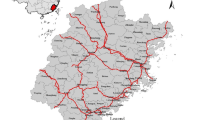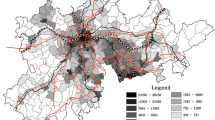Abstract
Under the background of ‘the Belt and Road’ initiative, the economic cooperation has great potential between China and Russia. The railway accessibility has an important influence on the economic connections of cities along the railway line. This paper studied the Sino-Russian transnational economic connection based on the railway class accessibility along Trans-Siberian railway (the transnational China railway branch line). The results are as following. First, the railway accessibility of the Chinese nodes is stronger than that of the Russian nodes, which in general displays a tendency of space attenuation from China to the Sino-Russian border, then to Russia. Spatially, the railway accessibility within the study area shows a ‘High East, Low West’ and ‘High South, Low North’ spatial pattern. The railway accessibility of the nodes, which are located at the beginning and end of the railway line, is weaker than those nodes located in the middle of the line. Second, the railway accessibility and external economic connection intensity summation of the nodes show a positive relationship along the railway line. The economic connection intensity summation of different nodes presents obvious regional differentiation. Finally, as economic connection network has evolved, the small world effect of Sino-Russian railway economic connection network becomes strong.
Similar content being viewed by others
References
Andersson D E, Shyr O F, Fu J, 2010. Does high-speed rail accessibility influence residential property prices? Hedonic estimates from southern Taiwan. Journal of Transport Geography, 18(1): 166–174. doi: 10.1016/j.jtrangeo.2008.10.012
Bruinsma F, Rietveld P, 1998. The accessibility of European cities: theoretical framework and comparison of approaches. Environment and Planning A: Economy and Space, 30(3): 499–521. doi: 10.1068/a300499
Bunnell T, Barter P A, Morshidi S, 2002. Kuala lumpur metropolitan area: a globalizing city-region. Cities, 19(5): 357–370. doi: 10.1016/S0264-2751(02)00036-7
Chen Y, Jin F J, Lu Y Q et al., 2018. Development history and accessibility evolution of land transportation network in Beijing-Tianjin-Hebei region over the past century. Journal of Geographical Sciences, 28(10): 1500–1518. doi: 10.1007/s11442-018-1558-x
Chu Nanchen, Zhang Pingyu, 2018. Transnational urban economic connection based on railway accessibility—taking Sino-Russian K19/K20 class train as an example. Economic Geography, 38(6): 10–18. (in Chinese)
Condeço-Melhorado A, Gutiérrez J, García-Palomares J C, 2011. Spatial impacts of road pricing: accessibility, regional spillovers and territorial cohesion. Transportation Research Part A: Policy and Practice, 45(3): 185–203. doi: 10.1016/j.tra.2010.12.003
Dai Teqi, Jin Fengjun, 2008. Spatial interaction and network structure evolvement of cities in terms of China’s rail passenger flows. Chinese Geographical Science, 18(3): 206–213. doi: 10.1007/s11769-008-0206-2
Delmelle E C, Casas I, 2012. Evaluating the spatial equity of bus rapid transit-based accessibility patterns in a developing country: the case of Cali, Colombia. Transport Policy, 20: 36–46. doi: 10.1016/j.tranpol.2011.12.001
Djankov S, Freund C, 2002. Trade flows in the former Soviet Union, 1987 to 1996. Journal of Comparative Economics, 30(1): 76–90. doi: 10.1006/jcec.2001.1752
Dong S C, Yang Y, Li F J et al., 2018. An evaluation of the economic, social, and ecological risks of China-Mongolia-Russia high-speed railway construction and policy suggestions. Journal of Geographical Sciences, 28(7): 900–918. doi: 10.1007/s11442-018-1512-y
Federal State Statistics Service (Rosstat), 2016. Russia in Figures. Moscow: Federal State Statistics Service.
Geertman S C M, van Eck J R R, 1995. GIS and models of accessibility potential: an application in planning. International Journal of Geographical Information Systems, 9(1): 67–80. doi: 10.1080/02693799508902025
Goetz A R, 1992. Air passenger transportation and growth in the U.S. urban system, 1950–1987. Growth and Change, 23(2): 217–238. doi: 10.1111/j.1468-2257.1992.tb00580.x
Gutiérrez J, González R, Gómez G, 1996. The European high-speed train network: predicted effects on accessibility patterns. Journal of Transport Geography, 4(4): 227–238. doi: 10.1016/S0966-6923(96)00033-6
Gutiérrez J, Urbano P, 1996. Accessibility in the European Union: the impact of the trans-European road network. Journal of Transport Geography, 4(1): 15–25. doi: 10.1016/0966-6923(95)00042-9
Gutiérrez J, 2001. Location, economic potential and daily accessibility: an analysis of the accessibility impact of the high-speed line Madrid-Barcelona-French border. Journal of Transport Geography, 9(4): 229–242. doi: 10.1016/S0966-6923(01)00017-5
Gutiérrez J, Condeço-Melhorado A, Martín J C, 2010. Using accessibility indicators and GIS to assess spatial spillovers of transport infrastructure investment. Journal of Transport Geography, 18(1): 141–152. doi: 10.1016/j.jtrangeo.2008.12.003
Gutiérrez J, Condeço-Melhorado A, López E et al., 2011. Evaluating the European added value of TEN-T projects: a methodological proposal based on spatial spillovers, accessibility and GIS. Journal of Transport Geography, 19(4): 840–850. doi: 10.1016/j.jtrangeo.2010.10.011
Hansen W G, 1959. How accessibility shapes land use. Journal of the American Institute of Planners, 25(2): 73–76. doi: 10. 1080/01944365908978307
Heilongjiang Province Bureau of Statistics, Survey Organization of Heilongjiang, 2016. Heilongjiang Statistical Yearbook 2016. Beijing: China Statistics Press. (in Chinese)
Jiang Haibing, Qi Yi, Li Chuanwu, 2018. China’s city high-speed rail (HSR) passenger spatial linkage pattern and its influence factors. Economic Geography, 38(7): 26–33. (in Chinese)
Jiao Jingjuan, Wang Jiaoe, Jin Fengjun et al., 2016. Understanding relationship between accessibility and economic Growth: a case study from China (1990–2010). Chinese Geographical Science, 26(6): 803–816. doi: 10.1007/s11769-016-0831-0
Jin Fengjun, 2003. Study on development strategy of shipping centers and transportation networks in the yellow sea rim. Chinese Geographical Science, 13(2): 97–103. doi: 10.1007/s11769-003-0001-z
Jin F J, Wang C J, Li X W et al., 2010. China’s regional transport dominance: density, proximity, and accessibility. Journal of Geographical Sciences, 20(2): 295–309. doi: 10.1007/s11442-010-0295-6
Keeble D, Owens P L, Thompson C, 1982. Regional accessibility and economic potential in the European community. Regional Studies, 16(6): 419–432. doi: 10.1080/09595238200185421
Khadaroo J, Seetanah B, 2008. The role of transport infrastructure in international tourism development: a gravity model approach. Tourism Management, 29(5): 831–840. doi: 10.1016/j.tourman.2007.09.005
Koopmans C, Groot W, Warffemius P et al., 2013. Measuring generalised transport costs as an indicator of accessibility changes over time. Transport Policy, 29: 154–159. doi: 10.1016/j.tranpol.2013.05.005
Kwan M P, Murray A T, O’Kelly M E et al., 2003. Recent advances in accessibility research: representation, methodology and applications. Journal of Geographical Systems, 5(1): 129–138. doi: 10.1007/s101090300107
López E, Monzón A, Ortega E et al., 2009. Assessment of cross-border spillover effects of national transport infrastructure plans: an accessibility approach. Transport Reviews, 29(4): 515–536. doi: 10.1080/01441640802627974
Li S M, Shum Y M, 2001. Impacts of the national trunk highway system on accessibility in China. Journal of Transport Geography, 9(1): 39–48. doi: 10.1016/S0966-6923(00)00040-5
Linneker B, Spence N, 1996. Road transport infrastructure and regional economic development: the regional development effects of the M25 London orbital motorway. Journal of Transport Geography, 4(2): 77–92. doi: 10.1016/0966-6923(96)00001-4
Ma Xiaolei, Ma Yanji, 2016. The transportation accessibility and comprehensive economic levels of Chinese cities at prefecture level or above based on GIS. Journal of Arid Land Resources and Environment, 30(4): 8–13. (in Chinese)
Matsumoto H, 2004. International urban systems and air passenger and cargo flows: some calculations. Journal of Air Transport Management, 10(4): 239–247. doi: 10.1016/j.jairtraman.2004.02.003
Monzón A, Ortega E, López E, 2013. Efficiency and spatial equity impacts of high-speed rail extensions in urban areas. Cities, 30: 18–30. doi: 10.1016/j.cities.2011.11.002
National Bureau of Statistics of China, 2016. China City Statistical Yearbook. Beijing: China Statistics Press. (in Chinese)
O’Kelly M E, 1998. A geographer’s analysis of hub-and-spoke networks. Journal of Transport Geography, 6(3): 171–186. doi: 10.1016/S0966-6923(98)00010-6
Richmond S, Bloom G, Di Duca M et al., 2016. Trans-Siberian Railway. Beijing: China Cartographic Publishing House, 360–374. (in Chinese)
Russon M G, Vakil F, 1995. Population, convenience and distance decay in a short-haul model of United States air transportation. Journal of Transport Geography, 3(3): 179–185. doi: 10.1016/0966-6923(95)00002-K
Sasaki K, Ohashi T, Ando A, 1997. High-speed rail transit impact on regional systems: does the Shinkansen contribute to dispersion? The Annals of Regional Science, 31(1): 77–98. doi: 10.1007/s001680050040
Shen G Q, 2004. Reverse-fitting the gravity model to inter-city airline passenger flows by an algebraic simplification. Journal of Transport Geography, 12(3): 219–234. doi: 10.1016/j.jtrangeo.2003.12.006
Tribby C P, Zandbergen P A, 2012. High-resolution spatiotemporal modeling of public transit accessibility. Applied Geography, 34: 345–355. doi: 10.1016/j.apgeog.2011.12.008
Wachs M, Kumagai T G, 1973. Physical accessibility as a social indicator. Socio-Economic Planning Sciences, 7(5): 437–456. doi: 10.1016/0038-0121(73)90041-4
Wang Chengjin, Cheng Jiajia, 2016. Spatial pattern of expressway network accessibility and evolution in China. Scientia Geographica Sinica, 36(6): 803–812. (in Chinese)
Wang Jiechen, Wu Jiayi, Ni Jianhua et al., 2018. Relationship between urban road traffic characteristics and road grade based on a time series clustering model: a case study in Nanjing, China. Chinese Geographical Science, 28(6): 1048–1060. doi: 10.1007/s11769-018-0982-2
Weidlich W, Haag G, 1999. An Integrated Model of Transport and Urban Evolution: with An Application to A Metropole of an Emerging Nation. Heidelberg: Springer. doi: 10.1007/978-3-642-60240-5
Zhu X, Liu S X, 2004. Analysis of the impact of the MRT system on accessibility in Singapore using an integrated GIS tool. Journal of Transport Geography, 12(2): 89–101. doi: 10. 1016/j.jtrangeo.2003.10.003
Zook M A, Brunn S D, 2005. Hierarchies, regions and legacies: european cities and global commercial passenger air travel. Journal of Contemporary European Studies, 13(2): 203–220. doi: 10.1080/14782800500212459
ФЕДЕРАЛЬНАЯ СЛУЖБА ГОСУДАРСТВЕННОЙ СТАТИС ТИКИ (Росстат) (Federal Office for State Statistics), 2016. РЕГИОНЫ РОССИИ Основные характеристики субъектов Российской Федерации. Москва: Федеральная служба госу дарственной статистики.
Author information
Authors and Affiliations
Corresponding author
Additional information
Foundation item: Under the auspices of National Science and Technology Basic Project of the Ministry of Science and Technology of China (No. 2017FY101303-1), National Natural Science Foundation of China (No. 41571152, 41771179), the Knowledge Innovation Program of CAS (No. ZDRW-ZS-2017-4-3-4, ZDBS-SSW-SQC)
Rights and permissions
About this article
Cite this article
Chu, N., Zhang, P. & Li, H. Transnational Economic Connection Analysis Based on Railway Class Accessibility Between China and Russia. Chin. Geogr. Sci. 29, 872–886 (2019). https://doi.org/10.1007/s11769-019-1064-9
Received:
Accepted:
Published:
Issue Date:
DOI: https://doi.org/10.1007/s11769-019-1064-9




